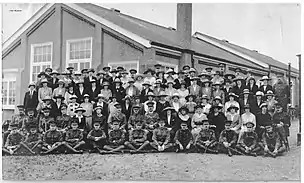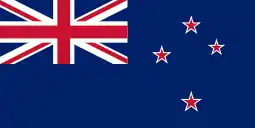Educational and Training Services Branch
The Educational and Training Services form part of the Adjutant General's Corps and have done since 1992 when this Corps of the British Army was formed. Their remit is to continue the general education of soldiers and officers alike, as well as the actual military training of the soldiers of the Army.
| Educational & Training Services | |
|---|---|
 | |
| Active | 1845 as the Corps of Army Schoolmasters |
| Country | |
| Branch | |
| Size | c.300 Regular Officers c.200 Reservist Officers |
| HQ | Education Branch, Army HQ, Andover, Hampshire |
| Motto(s) | 'Amino Et Fide' Courage and Faith |
| March | Gaudeamus Igitur ("Let us rejoice") |
| Mascot(s) | Minerva |
| Anniversaries | Education Sunday, the First Sunday in June. |
| Insignia | |
| Tactical Recognition Flash |  |
History
The Educational and Training Services Branch can trace its history back to 1762 when the First Regiment of Guards (Grenadiers) based at the Tower of London established a Unit School.[1] In 1797 the Royal Artillery opened a Regimental School at Woolwich Station, and in 1812 the British Parliament first provided funding for Army schools.[1] This was the first widespread, state funded education system in the United Kingdom.[2]

Following the establishment of the Regimental School System, all Army Sergeant Schoolmasters were formally trained in The Monitorial System this being the most modern form of instruction at the time.[3] Thus, the Corps of Army Schoolmasters was established in 1845[4] to provide Education for Soldiers and their families. References exist to Army Schools, now Army Education Centres, being in operation continually since 1898.[5]
In 1992 the Royal Army Educational Corps was disbanded and its Officers transferred into the newly formed Educational and Training Services Branch of the Adjutant General's Corps.[6]
Traditions
Members of the ETS Branch are entitled to wear blue socks with their Number 2 Service Dress (British Army) uniforms; this is a unique part of their uniform, as a variation of socks is not seen in other units which wear infantry pattern service dress.[7]
Organisation
ETS is an all officer, all graduate, branch. It provides education to Regular and Reserve Army personnel, helping them to meet the challenges of the 21st century by training for certainty and educating for uncertainty. Officers are primarily employed as follows:[8]
- Learning Development Officers (LDOs) in Army Education Centres (AECs) and on Operations developing soldiers command, leadership and management skills in order to prepare them for promotion.
- Training Development Advisors (TDAs - usually in the rank of Captain) in the Army's Capability Directorates, Army Recruiting and Initial Training Command[9] (ARITC) or in Defence Training Establishments.
- Learning and Development Advisors[10] (LDAs - usually in the rank of Major) who specialise in the analysis, design, delivery and assurance of Defence wide training and educational courses[11].
- Specialist Language Training Managers within the Defence Centre for Languages and Culture [12] in either Foreign[13] or English Language[14] training. For example Officer in Command of the Pre-RMAS course for Officer Cadets from foreign militaries attending courses at Royal Military Academy Sandhurst.[14]
- Supporting Short Term Training Teams (STTTs) abroad as the Education and Training Specialist.
- Headquarters, Operational and Training appointments.
Career pathway
An ETS Officer would usually start their career in one of two roles: Learning Development Officer (LDO) in an Army Education Centre, or an Instructor at the Army Foundation College Harrogate (AFC(H)).[15] Later roles include: Army Training Regiment (ATR) LDOs, Army School of Education (ASE) Instructor, or assignments in the wider Army.[15]
Affiliation
The Educational and Training Services Branch is a member of the International Association for Military Pedagogy (IAMP).
Affiliated Corps
.svg.png.webp) Australia - Royal Australian Army Educational Corps
Australia - Royal Australian Army Educational Corps New Zealand - Royal New Zealand Educational Corps
New Zealand - Royal New Zealand Educational Corps
Notable Alumni
- Quentin Blake (cartoonist) during National Service served in the Royal Army Education Corps.
- "I joined the educational corps and taught enlisted boys at Aldershot": "I tried to teach them English, which in most cases meant punctuation and spelling. In some ways it was like Dotheboys Hall, and they used to run away. Towards the end of my two years, I illustrated what I suppose was my first book, a pamphlet called English on Parade."[16]
- Archie Cecil Thomas White VC after serving as a Captain in the Alexandra, Princess of Wales's Own (Yorkshire Regiment) transferred to the Army Education Corps and reached the rank of Colonel to serve as Command Education Officer Home Forces from November 1940 to August 1943.[17]
- Ronald Barnes, 3rd Baron Gorell founder of the Royal Army Education Corps[18] on 15 June 1920.
References
- White, A.C.T. (1963). The Story of Army Education. 182, High Holborn, London, WC1: Harrap.CS1 maint: location (link)
- "The Regimental School System and Education in the British Army in the Napoleonic Era"
- "The Army Schoolmaster And The Development of Elementary Education In The Army, University of London"
- "Royal Army Educational Corps | National Army Museum". www.nam.ac.uk. Retrieved 2020-10-28.
- Smith, E.A., 1993. The army schoolmaster and the development of elementary education in the army, 1812-1920 (Doctoral dissertation, Institute of Education, University of London).
- "Adjutant Generals Corps, History of the Corps"
- Adjutant General's Corps Dress Regulations and Instructions, May 2004
- "Educational and Training Services". Ministry of Defence. Retrieved 31 July 2015.
- "Home Command". www.army.mod.uk. Retrieved 2021-02-09.
- Press Release. "British Army". www.facebook.com. Retrieved 2021-02-09.
- JSP 822 (Aug 2020). "Defence Direction and Guidance for Training and Education" (PDF).
- "Defence Centre for Languages and Culture - Defence Academy of the United Kingdom". www.da.mod.uk. Retrieved 2020-12-18.
- "Foreign Languages Wing - Defence Academy of the United Kingdom". www.da.mod.uk. Retrieved 2020-12-18.
- "English Language Wing". www.da.mod.uk. Retrieved 2020-12-18.
- "ETS Recruitment". www.army.mod.uk. Retrieved 2020-10-28.
- Blake, Quentin (14 Jul 2017). "Quentin Blake - National service: basic training and the Royal Army Education Corps".
- "Archibald "Archie" CT White VC - victoriacross". www.vconline.org.uk. Retrieved 2020-11-08.
- Beach, Jim (2010). "BOLSHEVISING THE ARMY? LORD GORELL AND ARMY EDUCATION, 1918-1920". Journal of the Society for Army Historical Research. 88 (354): 170–198. ISSN 0037-9700.